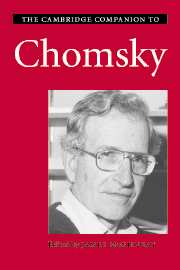Book contents
- Frontmatter
- Introduction
- Part I Chomsky on the human language
- 1 Chomsky’s science of language
- 2 Plato’s Problem, UG, and the language organ
- 3 Grammar, levels, and biology
- 4 How the brain begets language
- 5 Chomsky and Halle’s revolution in phonology
- 6 Universal aspects of word learning
- Part II Chomsky on the human mind
- Part III Chomsky on values and politics
- Notes
- References
- Index
3 - Grammar, levels, and biology
from Part I - Chomsky on the human language
Published online by Cambridge University Press: 28 May 2007
- Frontmatter
- Introduction
- Part I Chomsky on the human language
- 1 Chomsky’s science of language
- 2 Plato’s Problem, UG, and the language organ
- 3 Grammar, levels, and biology
- 4 How the brain begets language
- 5 Chomsky and Halle’s revolution in phonology
- 6 Universal aspects of word learning
- Part II Chomsky on the human mind
- Part III Chomsky on values and politics
- Notes
- References
- Index
Summary
Introduction
Language is an immensely rich phenomenon, presenting vast challenges for the linguist, the scientist of this phenomenon. Among the most central, and most difficult, questions are ones concerning the nature of the capacity we all have to speak a language. Just what is this capacity, and how does it arise in the individual? We thus have (among many others) the two following related questions:
- What is the correct characterization of someone who “knows a language” (in general terms, who has command of a systematic connection between sound and meaning)?
- How does that systematic connection arise in the individual?
For the first of these questions, the linguist hopes to account, in an explicit way, for the speaker’s ability to put together and understand sentences, including ones new to the speaker (and often new to all speakers), and for the speaker’s ability to judge potential sentences as “acceptable” (John left) or “unacceptable” (Left John). For the second question, a particularly difficult one given how complex the capacity seems to be and how quickly it is acquired, the linguist seeks to discover what aspects of the capacity are determined by the child’s experience, and how this determination (“language learning”) takes place. For a half century, Noam Chomsky has been developing a theory of language that deals with these two questions, by positing explicit formulations of human language capacity in terms of a productive “computational” system, most of whose properties are present in advance of experience, “wired in” in the structure of the human brain. Thus, Chomsky conceives of his enterprise as part of psychology, ultimately biology.
- Type
- Chapter
- Information
- The Cambridge Companion to Chomsky , pp. 60 - 83Publisher: Cambridge University PressPrint publication year: 2005
- 5
- Cited by



